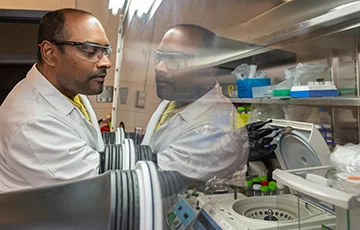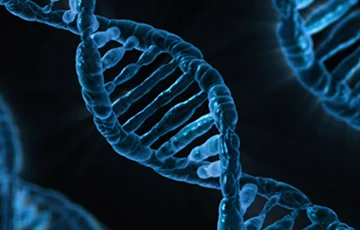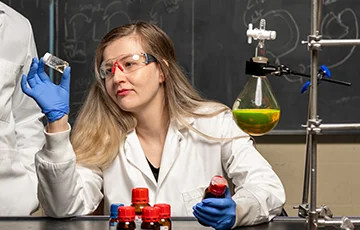Biochemistry & Biophysical Chemistry
These areas of research involve the study of the chemical and physical processes within and related to living organisms.
- Home
- Departmental Directory
- Liberal Arts
- Department of Chemistry & Biochemistry
- Research
- Biochemistry & Biophysical Chemistry
Researching the Fundamentals of Living Systems
Biochemistry focuses on the chemical processes within and related to living organisms. It bridges the gap between chemistry and biology, studying the structure, composition, and reactions of biological molecules, and how they function. This field helps understand diseases, genetics, nutrition, and more.
Biophysical chemistry seeks to understand the fundamental driving forces of living systems, applying principles of physical and analytical chemistry to understand the processes of life at the nano and microscales.
Our faculty are researching:
- Designing hybrid materials for health and energy
- Exploring cell stress via DNA/RNA structures
- Studying polymers for targeted drug delivery
Research Projects
-

Professor Saumen Chakraborty
Nature carries out biochemical reactions with exquisite selectivity and efficiency often employing metal ions, metal cofactors and metal clusters organized in predefined architectures. Learning from nature the Chakraborty group aims to combine inorganic/materials (metals, organometallic cofactors, and metal clusters) and bionano components (proteins, peptides, and DNA) to design artificial entities with novel functionalities and architectures unprecedented in nature. Such hybrid systems will have promising solutions to many global challenges such as energy and healthcare. Within this broad scope they are trying to gain fundamental understanding and explore their applications in the following research areas: 1) bioinorganic chemistry-designing novel metalloenzymes, 2) designing novel metallopeptides for Alzheimer’s disease and 3) exploring the role of gold nanoclusters in energy and catalysis.
Chakraborty Group -

Professor Sujay Ray
Prof. Ray's research group studies how biological systems work at the nanoscale, focusing on cellular stress response. We look at how certain structures made of DNA/RNA help cells manage resources and adapt to challenging stress conditions by prioritizing essential functions. We aim to understand how these complex DNA/RNA structures interact with different proteins to manage the demands of the cell. Our goal is to clearly link between structural attributes and functional response and ultimately harness these insights for biotechnological innovations and clinical intervention. To accomplish this, we develop and apply novel single-molecule manipulation and detection techniques, and nanoscale engineering. Our research projects combine approaches from a variety of disciplines including chemistry, physics, molecular biology, and engineering we collaborate with researchers from these various disciplines.
Ray Lab -

Professor Eden Tanner
Dr. Eden E. L. Tanner of the University of Mississippi will studies a novel class of polymers that consist of a linear hydrophobic section connected to a highly branched hydrophilic block. This distinct structural configuration bestows interesting properties on the polymer that can potentially be exploited for use as in drug delivery or related molecular transport applications. The Tanner Lab aims to gain a better understanding of the properties of this class of polymers, in particular the nature and strength of interactions that control the self-assembly of the polymers into uniform nano-size aggregates. The fundamental physical chemistry and polymer chemistry knowledge to be gained from this research may provide guiding principles for the rational design of polymers for biomedical or pharmaceutical applications.
Tanner Lab
Biochemistry Faculty
Saumen Chakraborty
- Associate Professor of Chemistry & Biochemistry
Sujay Ray
- Assistant Professor of Chemistry and Biochemistry
Joshua Sharp
- Professor of Pharmacology, Research Professor in RIPS, and Affiliated Professor of Chemistry and Biochemistry
Eden Tanner
- Assistant Professor of Chemistry and Biochemistry and Co-Director for the Center for Nano-Bio Interactions
Randy Wadkins
- Professor of Chemistry & Biochemistry
Biophysical Chemistry Faculty
Nathan Hammer
- Professor of Chemistry and Biochemistry
Jinchao Lou
- Assistant Professor of Chemistry and Biochemistry
Sujay Ray
- Assistant Professor of Chemistry and Biochemistry
Joshua Sharp
- Professor of Pharmacology, Research Professor in RIPS, and Affiliated Professor of Chemistry and Biochemistry
Vig Sundaresan
- Assistant Professor of Chemistry and Biochemistry
Eden Tanner
- Assistant Professor of Chemistry and Biochemistry and Co-Director for the Center for Nano-Bio Interactions
Randy Wadkins
- Professor of Chemistry & Biochemistry
